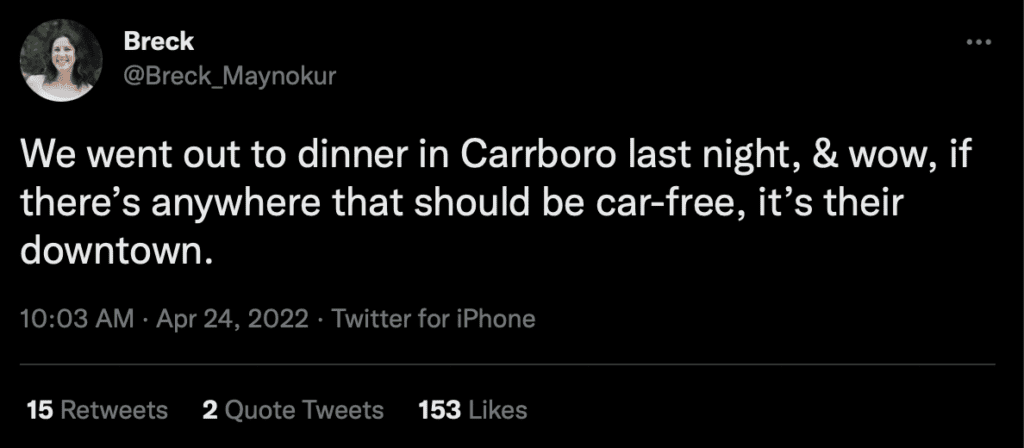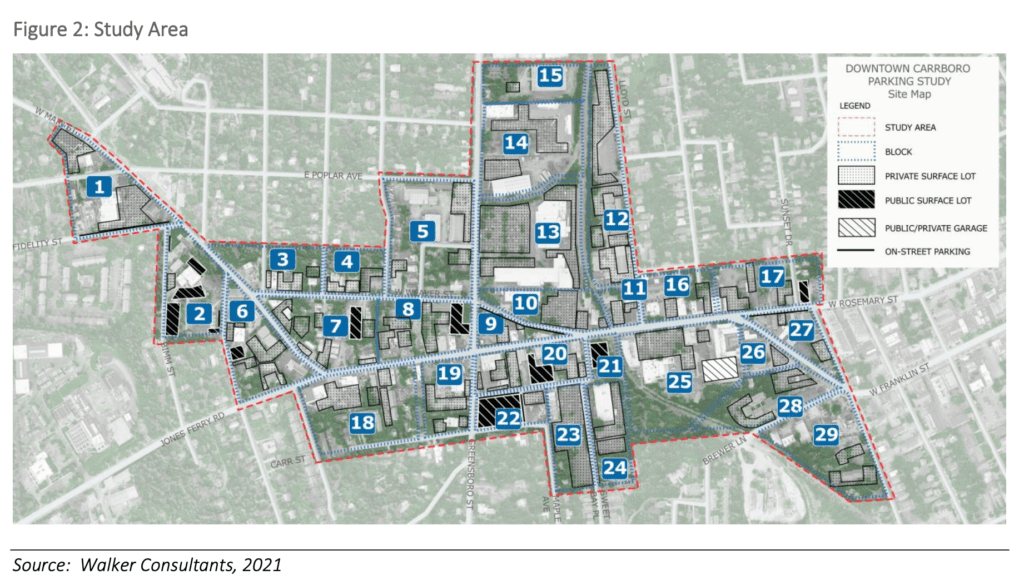This past weekend, Breck Maynokur, a real estate professional from Durham who describes herself as a “Californian in the South,” made a common observation about downtown Carrboro’s suitability for walkability:

Her tweet received 153 likes, and was probably seen and appreciated by 20 times that number. Other Carrboro elected officials, including Susan Romaine, Sammy Slade, Danny Nowell, Barbara Foushee, Randee Haven-O’Donnell, and, of course, Mayor Damon Seils, have all voiced support for making downtown safer for pedestrians and cyclists and reducing the number of cars on our downtown streets.
If reducing the number of cars downtown has wide support, why haven’t we made more progress? In part, the answer is that the town hasn’t made it a priority. The conversation typically goes like this:
- Carrboro residents, loudly: Let’s reduce the number of cars downtown and make way for people. Party in the streets!
- Carrboro business owners, quietly, but effectively: But where will our customers park? How else will people get to downtown Carrboro?
- Carrboro government and elected officials: We can’t do anything that might upset anyone, so let’s stick with the status quo. By the way, have you heard about our latest plans to add more parking downtown?For decades, debates about parking in Carrboro have followed this familiar pattern, which has led to a downtown pocked with parking craters.
Tonight, however, things may begin to change when the town of Carrboro discusses a new parking study. The study was conducted by the same consultants (Walker) who recently worked with Chapel Hill on its ill-advised payment-in-lieu policy proposal. (That proposal is currently on hold, after being voted down by the Planning Commission and Transportation and Connectivity Advisory Board. To be fair, Walker is a good firm, one of the leading experts on parking in the country. The problem with Chapel Hill’s proposal was the town’s directive, not the consultant).
As Geoff Green noted in his preview of tonight’s meeting, the headline findings of the report are alarming:
The 2022 report notes that there is “ample existing space availability across the downtown,” with about 3,604 overall parking spaces, and maximum occupancy of around 50%. Yes, that’s right, at peak times about half of the spaces are unoccupied! The bugaboo is, as always, lack of enforcement of the parking time limitations, challenges finding the public parking and available spaces, and the Town’s ongoing failure to get private property owners to agree to open up private spaces for public use and certain times.
Of these 3,604 spots, all but 275 spaces (the Hampton Inn garage) are on surface lots. The average size of a parking space is 320 square feet (some say a bit more, some say a bit less, but 320 sq. feet per space captures both the space itself and the space needed to access it), which means that 1,065,280 square feet of prime downtown real estate is reserved for parking spaces. Here’s what this looks like on a map:

The boxes that are shaded black are public lots. The boxes that are shaded with grey dots are private lots. The little bit of green and white left? That’s where people in Carrboro eat at restaurants, go to the doctor, get groceries, hang out, and do everything else. The remaining 1,065,280 square feet—24.5 acres—is reserved for parking. To put this in perspective, the new library (the 203 Project) will sit on just .883 acres. We could build another 29 libraries of the same size downtown, and still have room left over. To use another example, in Chapel Hill there is a proposal to build a seven-story apartment building with 150 apartments downtown on just .64 acres of land. By just leveraging its existing parking spaces, Carrboro could build 38 such buildings, with 5,700 apartments, all within a compact walkable downtown, close to transit, job opportunities, and all the amenities Carrboro currently has to offer.
While many might not want the “Paris of the Piedmont,” to enact policies that bring it closer to Paris, France—which is in the process of phasing out automobiles entirely—surely there’s a middle ground between the status quo of “free” parking (in quotes because parking is always paid by someone) for all and moving toward a car-free paradise downtown.
The report offers all kinds of suggestions for fixing Carrboro’s parking problems, but most of them boil down to a simple truth—Carrboro’s refusal to charge for parking, and its high parking requirements, have hurt downtown businesses and unnecessarily caused parking crunches at a few key times and places (notably the Saturday farmer’s market) while leaving parking overly plentiful the rest of the time. Charging for parking would help the town overcome a few big hurdles:
- It would deter parking scofflaws—Even though the town limits parking to 2 hours per day on some lots, the rules are not strictly enforced. For many, including those who work or attend school at UNC, Carrboro has effectively become a free park-and-ride lot. People park in Carrboro and go to UNC’s campus, taking up space that could be used more productively. Charging for parking would generate enough revenue to pay for enforcement, which help us solve another problem:
- It would incentivize parking lot land barons to more productively use their land—In Carrboro, 2,895 of the town’s 3,666 parking spaces are on privately-owned land. Fitch Lumber Company and Carr Mill Mall alone own a lot of private parking, but they are reluctant to develop it because the town is not effectively managing its parking supply. If they knew that customers could always find a paid space on a public lot, they might be open to building more housing, office space, and other things downtown.
- Carrboro could create a park once, or not at all, culture. Carrboro has a lot to offer in its downtown business district, and yet the current parking culture encourages visitors to frequently move their car as they go from place to place, or park all day in a public lot. Neither is healthy for downtown. We need to make it easier and safer to get downtown without a car, and encourage people to park once, in a public or private paid lot, and then spend more time taking advantage of everything our community has to offer. We can’t do this unless we charge for parking.
While there’s much more to say on the subject, Walker Consultants, who created the parking report, say it best in their conclusion:

At tonight’s meeting, let’s hope that the Council is willing to begin a tough but necessary conversation about moving to paid parking, which will allow us to work toward building the walkable Carrboro we all say we want.